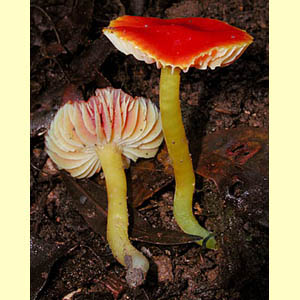
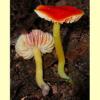
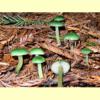
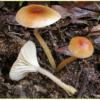
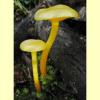
Gliophorus is a synonym of Hygrocybe and species formerly placed in Gliophorus fall under Hygrocybe subgenus Pseudohygrocybe. Also included in this subgenus in the key is H. kandora (= H. coccinea in the sense of Cleland), which belongs in subgenus Hygrocybe (see discussion in Generic Circumscription section).
The other two subgenera of Hygrocybe (subgenera Cuphophyllus and Hygrocybe) are keyed out separately.
Bougher, N.L. & Young, A.M. (1997), Hygrophoraceae of Western Australia, Mycotaxon 63: 25–35, and 65: 525 for errata. [Description and Microcharacters of H. miniata and H. viscidibrunnea, and Illustration of H. viscidibrunnea]
Fuhrer, B. (2005), A Field Guide to Australian Fungi. Bloomings Books, Hawthorn. [Description and Illustration of H. chromolimonea, H. firma, H. fuhreri, H. graminicolor, H. leucogloea, H. lilaceolamellata, H. miniata, H. pseudograminicolor, H. psittacina, H. saltorivula, H. stevensoniae, H. xanthopoda and several unnamed species]
Fuhrer, B. & Robinson, R. (1992), Rainforest Fungi of Tasmania and South-east Australia. CSIRO Press, East Melbourne. [Illustration of H. chromolimonea, H. firma (as H. procera), H. graminicolor, H. lilaceolamellata and H. stevensoniae (as H. viridis)]
Grey, P. & Grey, E. (2005), Fungi Down Under. Fungimap, South Yarra. [Description, Illustration and Map for H. graminicolor]
Grgurinovic, C.A. (1997a), Larger Fungi of South Australia. The Botanic Gardens of Adelaide and State Herbarium and The Flora and Fauna of South Australia Handbooks Committee, Adelaide. [Description and Microcharacters of H. fuligineosquamosa, H. kandora (as H. coccinea) and H. kula and Illustration of the latter two species]
Horak, E. (1990), Monograph of the New Zealand Hygrophoraceae (Agaricales), New Zealand J. Bot. 28: 255–309. [Description, B&W Illustration and Microcharacters of H. cantharellus, H. chromolimonea (under Gliophorus), H. firma, H. graminicolor (under Gliophorus, and as Gliophorus pallidus), H. lilaceolamellata, H. miniata and H. stevensoniae (as Gliophorus viridis) and Key to New Zealand species, some as Gliophorus]
McCann, I.R. (2003), Australian Fungi Illustrated. Macdown Productions, Vermont. [Illustration of H. chromolimonea, and several other unidentified species]
Mills, A. & Monks, A. (1993), Unusual spore colouration within the family Hygrophoraceae: two distinctive taxa recorded from Tasmania, Mycotaxon 46: 85–91. [Description, B&W Illustration and Microcharacters of H. erythrocrenulata and discussion of characters of H. lilaceolamellata]
Young, A.M. (1999b), A field key to the Hygrophoraceae of south-eastern Australia, Australas. Mycol. 18: 63–69. [Field Key to known species]
Young, A.M. (1999a), The Hygrocybeae (Fungi, Basidiomycota, Agaricales, Hygrophoraceae) of the Lane Cove Bushland Park, New South Wales, Austrobaileya 5: 535–564. [Description and Microcharacters of H. anomala, H. aurantipes, H. cantharellus, H. chromolimonea, H. erythrocala, H. graminicolor, H. kula, H. lanecovensis and H. stevensoniae, and B&W Illustration of H. anomala and H. lanecovensis]
Young, A.M. (2000b), Additions to the Hygrophoraceae (Fungi, Agaricales) of south-eastern Australia, Muelleria 13: 1–36. [Description, B&W Illustration and Microcharacters of H. bolensis, H. firma, H. hypospoda and H. xanthopoda, and discussion of additional material of various species including H. erythrocrenulata (as H. sanguineocrenulata) and H. sylvaria]
Young, A.M. (2000c), Additions to the Hygrocybeae (Fungi, Hygrophoraceae) of Victoria. I, Muelleria 14: 51–64. [Description, B&W Illustration and Microcharacters of H. fuhreri, H. psittacina and H. saltorivula, and discussion of further collcetions of H. leucogloea]
Young, A.M. (2001a), Hygrocybe kula Grgur. revisited, Australas. Mycol. 19: 91–95. [Description and Microcharacters of H. kula (with Illustration) and H. rubronivea (with B&W Illustration), and discussion of characters of H. lanecovensis]
Young, A.M. (2001b), Remarks on Hygrophoraceae in or near Lamington National Park, south-east Queensland, Australia, Australas. Mycol. 19: 96–100. [Description, Illustration and Microcharacters of H. kouskosii]
Young, A.M. (2001d), Profiles of fungi. 120. Hygrocybe graminicolor (E. Horak) T.W. May & A.E. Wood, Mycologist 15: 37–38.[Description, Illustration and Microcharacters of H. graminicolor]
Young, A.M. (2002b), Hygrocybe boothii sp. nov. from Northern Queensland, Australas. Mycol. 21: 73–75. [Description, Illustration and Microcharacters of H. boothii]
Young, A.M. (2005a), Fungi of Australia: Hygrophoraceae, Australian Biological Resources Study, Canberra & CSIRO Publishing, Melbourne. [Description and Microcharacters of all Australian species, with B&W Illustration of all except for H. flammans, H. fuligineosquamosa and H. kula, along with Illustration of most species and a Key to species]
Young, A.M. (2005b), A Field Guide to the Fungi of Australia. University of New South Wales Press, Sydney. [Description and Illustration of H. miniata, and Description and B&W Illustration of H. cantharellus and H. graminicolor]
Young, A.M. & Mills, A.K. (2002), The Hygrophoraceae of Tasmania, Muelleria 16: 3–28. [Description, Illustration and Microcharacters of H. franklinensis, H. julietae and H. roseoflavida, and discussion of Tasmanian collections of H. anomala, H. cantharellus, H. chromolimonea, H. erythrocrenata, H. firma, H. graminicolor, H. irrigata, H. leucogloea, H. lilaceolamellata, H. miniata, H. pseudograminicolor and H. stevensoniae]
Young, A.M. & Wood, A.E. (1997), Studies on the Hygrophoraceae (Fungi, Homobasidiomycetes, Agaricales) of Australia, Austral. Syst. Bot. 10: 911–1030 [Description, B&W Illustration and Microcharacters of 30 species, including H. anomala (under subgenus Cuphophyllus), H. graminicolor (also as H. batesii, H. pallida and H. vallomarginata) and H. erythrocrenulata (as H. sanguineocrenulata)]
Young, A.M., Bougher, N.L. & Robinson, R.M. (2000), Hygrophoraceae of Western Australia II. Further taxa, Australas. Mycol. 19: 41–48. [Description, Illustration and Microcharacters of H. firma]
Young, A.M., Kearney, R. & Kearney, E. (2001), Additions to the Hygrophoraceae of Lane Cove Bushland Park, Australas. Mycol. 20: 79–86. [Description, B&W Illustration and Microcharacters of H. collucera, H. irrigata and H. kula]
